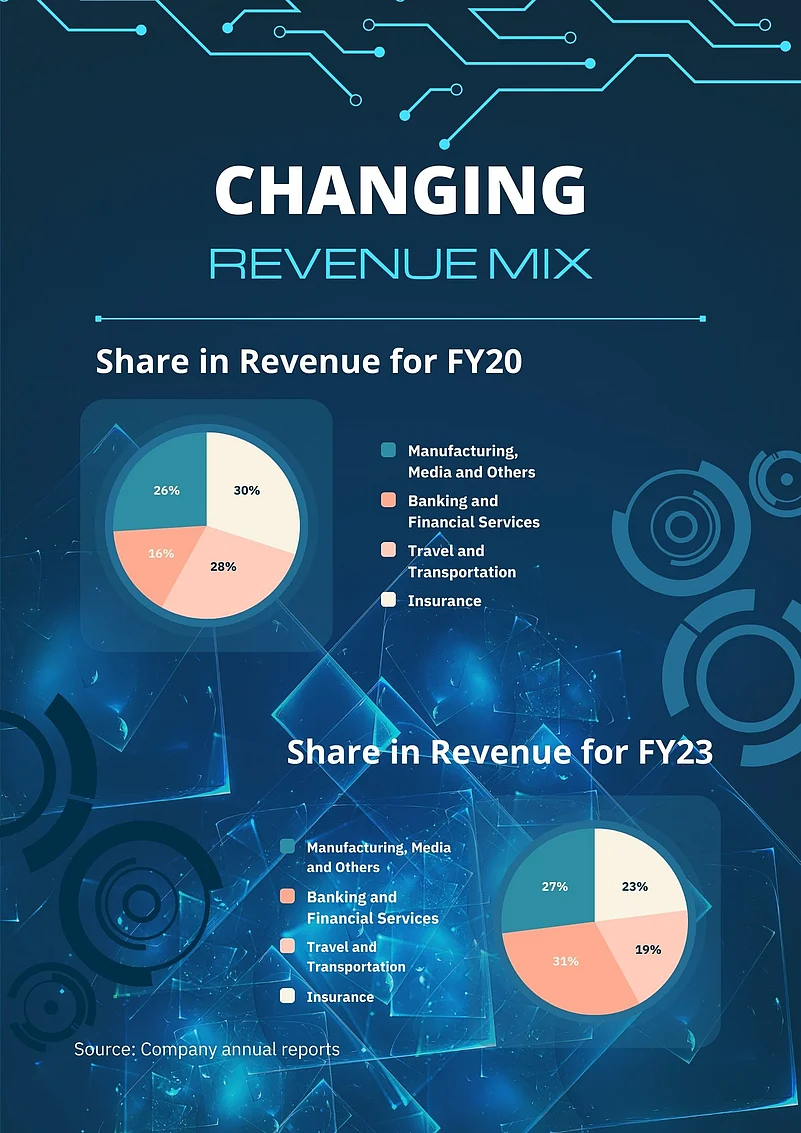After the IT services giant Infosys announced its Q1 results, the stocks of the firm fell over 9 per cent due to subdued growth outlook. The company had cut its revenue guidance to 1-3.50 per cent for the financial year. The results of the second quarter of FY24 have also not brought a lot of cheer. Tata Consultancy Services (TCS) saw its US dollar revenue decline for the first time in 13 quarters while Infosys cut its revenue guidance for the second time in this financial year.
Amidst this struggle of large size IT firms which is forcing them to cut revenue growth forecasts, a mid-size firm, Coforge, has set an ambitious goal of 100 per cent revenue growth in next five years. The second quarter of the financial year saw the company posting double digit growth in revenue. Coforge's financials show that the company’s revenue grew by 16 per cent year on year to reach Rs 2,276 crore.
While the tough operating environment for IT companies has attracted a lot of attention which has also affected Coforge's bottomline, Sudhir Singh, Chief Executive Officer (CEO) of Coforge, appears to be calm about it. In an interaction with Outlook Business, he says, “Firms like Coforge at a billion dollars are not even one per cent of the market spend. So, the current environment won’t have a very sizable impact on us which is why we are able to guide for a 13 to 16 per cent growth. We are confident we will be able to reach $2 billion in next five years.”
However, as the large share of company’s revenue comes from the US and the company is aiming to increase its presence in the market, there are questions of how much impact the slowdown in global economy will have on the IT company’s plan.
Adapting To Market Trends
It won’t be the first time the company had to react to changing market trends. Just before the pandemic hit, most of the company’s revenue came from Insurance and Travel and Hospitality segment. In FY20, they made up for 30 per cent and 28 per cent of total revenue respectively. However, things had to change when the pandemic hit.
Singh says that the company was one of the most exposed to the disruption caused by Covid-19 pandemic. “A large share of our business came from airports and airlines which came to a screeching halt during the pandemic. We were able to focus on banking and grow it substantially over the years,” he explains.

As seen in the annual reports of the company, the revenue mix in terms of category has changed over the last few years. FY23 data shows that banking and financial services made up for the highest share in consolidated revenue.
Due to a focus on improving execution and winning new deals, the order book of the company has also seen a strong growth in the last five years. Investors have also expressed confidence in the company’s stocks which have surged over 150 per cent year in five years. Narendra Solanki, Head of Fundamental Research at Investment Services of Anand Rathi Shares and Stock Brokers, says, “Strong deal wins, a robust deal pipeline, and good consistency in large deal wins (2–3 large deals every quarter) has remained encouraging for the company.”

Along with the boom in the IT services demand, Singh says the company has been able to establish its name due to strong order execution. He opines, “Only one thing differentiates a firm that delivers versus a firm that doesn't. Everyone can claim they're signing large deals, but it doesn't mean anything if your revenue doesn't grow.”
The company had recently reached the milestone of $1 billion revenue in FY23, which has buoyed confidence. It now plans to double it further and reach the $2 billion mark in the next five years. However, given the fact that the US banking sector has faced headwinds and the US economy slowing down, the company may have to grapple with a new reality of the US market.
Look To The Future
Recently, there have been murmurs about the need for Indian IT companies to look beyond the BFSI space which is the most important segment for them at the moment. The discussions have been prompted by the outlook for the US banking sector. In a recently published blog, the Federal Reserve Bank of New York said that the banking sector is still vulnerable, months after the fall of Silicon Valley Bank and First Republic Bank.
Commenting on the implications of stress in US banking sector, Vedant Rathi, Manager of Financial Advisory & Valuations Services at Aranca, says, “The recent developments may lead to banking clients procrastinating on IT spending decisions, given the capital constraints.”
Agreeing with the need to be wary about the US market in the coming years, Solanki says, “Company needs to reduce its heavy dependence on BFSI sector and will need to focus on new verticals, such as healthcare and retail, to reduce its reliance on the BFSI sector.”
Cutting reliance on the BFSI segment won’t be an easy task as the segment makes up for the majority of the revenue. Singh dismisses the concerns and exudes confidence that the current strategy of the company will bear fruit. “We'll continue to focus on BFSI and we will continue to use the profits that we get out of that segment to keep starting new segments. But we won't walk away from an area where we have grown so much,” he says.
How the coming quarters pan out remains to be seen but the company is confident of continuing with its guidance of 13-16 per cent growth in revenue. Singh points to the fact that Coforge’s growth depends on it being able to take away market share of other players not on the overall growth of the market. This is the reason why the company is confident of continuing on its growth path. The company has already changed its governance model this year wherein it became a 100 per cent board governed company after Baring PE, its promoters, offloaded its entire stake.
With an eye clearly on the $2 billion revenue goal, Singh has set out a clear goal for the leadership and the company. “You cannot talk about macros and excuses on why you didn't do it. You deliver one way or the other,” he asserts. The company has already adapted once to the changing reality of the market. Its $2 billion goal will depend on repeating the feat once again to sail through the storm engulfing US economy and the IT sector.






























